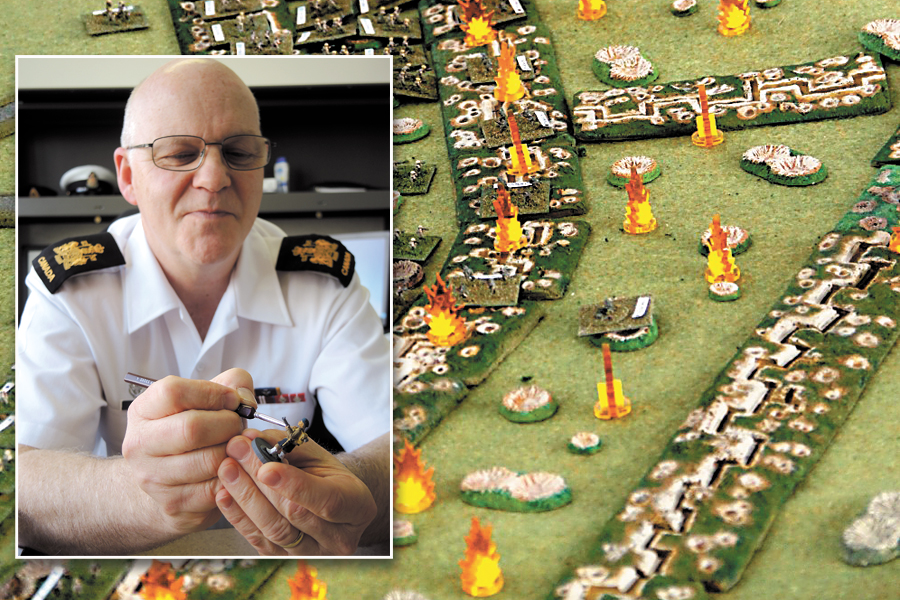Sailor creates detailed Vimy Ridge battle scene
By Lookout on Apr 27, 2017 with Comments 0

CPO1 Shawn Taylor touches up a miniature Blackwatch Highlander soldier used in his replica model of the Vimy Ridge battlefield. CPO1 Taylor and his collegue Robert Dunlop were invited to display their work at the Canadian War Museum in Ottawa over the April 8 weekend. Photo by Peter Mallett, Lookout
Peter Mallett, Staff Writer ~
A sailor’s miniature depiction of the Vimy Ridge battle site garnered plenty of onlookers at the Canadian War Museum in Ottawa over the April 8 weekend.
CPO1 Shawn Taylor, from Naval Personnel Training Group headquarters, was on hand to discuss his three-dimensional, historically accurate model with visitors during the 100th anniversary weekend commemorating the battle.
“Our table was surrounded by a large crowd of museum patrons the entire weekend,” he says.
The level of interest and interaction was so high he and his colleague Robert Dunlop were not able to battle using the 2,500 painted miniature soldiers meticulously placed on the 10 x 6 foot battlefield they had created, which replicated the 10 kilometre by 6 kilometre area where the battle took place.
“It caught us by surprise. The plan was for Robert and I and the two other volunteers at the display to conduct the battle throughout the day, but we spent all of our time answering people’s questions,” says CPO1 Taylor. “It also surprised me that so many of the approximately 2,000 people who attended had a personal or family connection to the war.”
CPO1 Taylor, 54, describes himself as hailing from an “all-military” family with his mother, father and four brothers all serving the Canadian Armed Forces during their lifetime. He also has a connection to the First World War. His grandfather William Holmes, a Lance Corporal with the 10th Battalion Canadian Infantry (today the Calgary Highlanders), was awarded a Distinguished Conduct Medal for his bravery at the Battle of the Amiens.
“Hearing stories about my grandfather, who died after the war and I never had a chance to meet, triggered in me an intense desire to want to know more and more about the First World War,” says CPO1 Taylor. “When I was a child I collected toy soldiers, saw the Battle of the Bulge board game, and then read Charles Grant’s book on miniature war gaming, and was hooked for life.”
His collection of miniatures hovers around 70,000, and covers everything from Lord of the Rings figures to modern infantry. Only a third of that number have actually been painted and mounted.
Dunlop and CPO1 Taylor began working on their Vimy model over two years ago. One of the biggest tasks was creating an underlay out of foam core board that was molded using topographical maps of the battle site. On top of that, the pair created trenches and roads out of latex, and accurately depicted locations of landmarks, military vehicles and soldiers.
“It looks like the real thing,” he says. “When you add the trenches in to the battlefield it gives it a new dynamic and everything appears to pop off the ground.”
The biggest challenge was properly depicting the German artillery placement. He says many of the original German Vimy Ridge records were destroyed when the Allies bombed Dresden and Berlin during the Second World War. The two men poured over hundreds of unofficial documents such as letters sent home from German soldiers. They even consulted Jack Sheldon an expert on Prussian and Bavarian fighters that helped them isolate the location of 62 of the 69 German batteries.
In October 2016, they sent a photo and email to museum staff pitching their display. A month later they got the response they were hoping for in the form of an invitation to appear at a Gala for the museum’s First World War Gallery on April 5, and the Vimy Ridge event on April 8 and 9.
“It was pure excitement for both myself and Robert when we heard back,” says CPO1 Taylor.
The best part of his trip to the nation’s capital was being able to help others learn about the battle.
“It was a great opportunity to educate. One of the big advantages about three-dimensional displays is it gives people context so they can actually see how the Canadian soldiers were deployed with other British, Australian and Indian soldiers on the battlefield, and the commanding position of the enemy, and the notable height and slope of Hill 145.”
Filed Under: Top Stories
About the Author:





